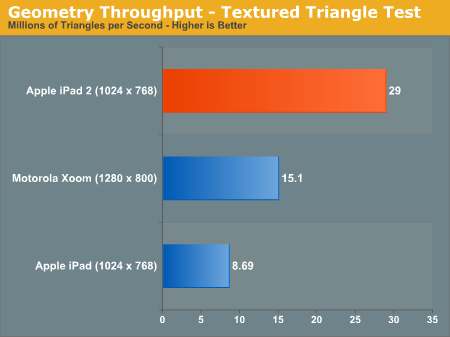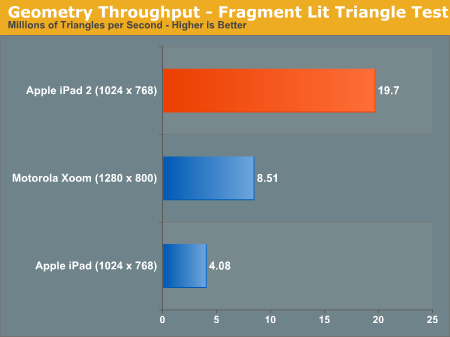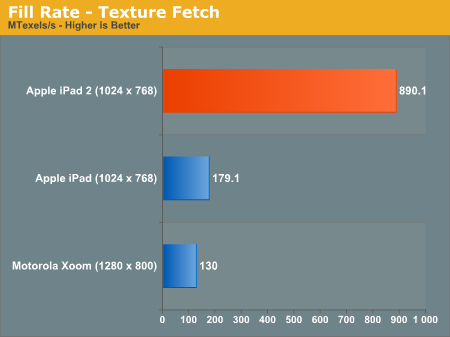Apple iPad 2 GPU Performance Explored: PowerVR SGX543MP2 Benchmarked
by Anand Lal Shimpi on March 12, 2011 3:04 PM EST- Posted in
- Smartphones
- Apple
- iPad
- GLBenchmark
- iPad 2
- Mobile
- Tablets
Earlier this morning we published our first impressions on Apple's iPad 2, including analysis on camera quality and a dive into the architecture behind Apple's A5 SoC. Our SoC investigation mostly focused on CPU performance, which we found to be a healthy 50% faster than the A4 in the original iPad - at least in web browsing. We were able to exceed Apple's claim of up to 2x performance increase in some synthetic tests, but even a 50% increase in javascript and web page loading performance isn't anything to be upset about. We briefly touched on the GPU: Imagination Technologies' PowerVR SGX 543MP2. Here Apple is promising up to a 9x increase in performance, but it's something we wanted to investigate.
Architecturally the 543MP2 has more than twice the compute horsepower of the SGX 535 used in Apple's A4. Each shader pipeline can execute twice the number of instructions per clock as the SGX 535, and then there are four times as many pipes in an SGX 543MP2 as there are in a 535. There are also efficiency improvements as well. Hidden surface removal works at twice the rate in the 543MP2 as it did in the 535. There's also a big boost in texture filtering performance as you'll see below.
As always we turn to GLBenchmark 2.0, a benchmark crafted by a bunch of developers who either have or had experience doing development work for some of the big dev houses in the industry. We'll start with some of the synthetics.
Over the course of PC gaming evolution we noticed a significant increase in geometry complexity. We'll likely see a similar evolution with games in the ultra mobile space, and as a result this next round of ultra mobile GPUs will seriously ramp up geometry performance.
Here we look at two different geometry tests amounting to the (almost) best and worst case triangle throughput measured by GLBenchmark 2.0. First we have the best case scenario - a textured triangle:

The original iPad could manage 8.7 million triangles per second in this test. The iPad 2? 29 million. An increase of over 3x. Developers with existing titles on the iPad could conceivably triple geometry complexity with no impact on performance on the iPad 2.
Now for the more complex case - a fragment lit triangle test:

The performance gap widens. While the PowerVR SGX 535 in the A4 could barely break 4 million triangles per second in this test, the PowerVR SGX 543MP2 in the A5 manages just under 20 million. There's just no competition here.
I mentioned an improvement in texturing performance earlier. The GLBenchmark texture fetch test puts numbers to that statement:

We're talking about nearly a 5x increase in texture fetch performance. This has to be due to more than an increase in the amount of texturing hardware. An improvement in throughput? Increase in memory bandwidth? It's tough to say without knowing more at this point.
| Apple iPad vs. iPad 2 | ||||
| Apple iPad (PowerVR SGX 535) | Apple iPad 2 (PowerVR SGX 543MP2) | |||
| Array test - uniform array access |
3412.4 kVertex/s
|
3864.0 kVertex/s
|
||
| Branching test - balanced |
2002.2 kShaders/s
|
11412.4 kShaders/s
|
||
| Branching test - fragment weighted |
5784.3 kFragments/s
|
22402.6kFragments/s
|
||
| Branching test - vertex weighted |
3905.9 kVertex/s
|
3870.6 kVertex/s
|
||
| Common test - balanced |
1025.3 kShaders/s
|
4092.5 kShaders/s
|
||
| Common test - fragment weighted |
1603.7 kFragments/s
|
3708.2 kFragments/s
|
||
| Common test - vertex weighted |
1516.6 kVertex/s
|
3714.0 kVertex/s
|
||
| Geometric test - balanced |
1276.2 kShaders/s
|
6238.4 kShaders/s
|
||
| Geometric test - fragment weighted |
2000.6 kFragments/s
|
6382.0 kFragments/s
|
||
| Geometric test - vertex weighted |
1921.5 kVertex/s
|
3780.9 kVertex/s
|
||
| Exponential test - balanced |
2013.2 kShaders/s
|
11758.0 kShaders/s
|
||
| Exponential test - fragment weighted |
3632.3 kFragments/s
|
11151.8 kFragments/s
|
||
| Exponential test - vertex weighted |
3118.1 kVertex/s
|
3634.1 kVertex/s
|
||
| Fill test - texture fetch |
179116.2 kTexels/s
|
890077.6 kTexels/s
|
||
| For loop test - balanced |
1295.1 kShaders/s
|
3719.1 kShaders/s
|
||
| For loop test - fragment weighted |
1777.3 kFragments/s
|
6182.8 kFragments/s
|
||
| For loop test - vertex weighted |
1418.3 kVertex/s
|
3813.5 kVertex/s
|
||
| Triangle test - textured |
8691.5 kTriangles/s
|
29019.9 kTriangles/s
|
||
| Triangle test - textured, fragment lit |
4084.9 kTriangles/s
|
19695.8 kTriangles/s
|
||
| Triangle test - textured, vertex lit |
6912.4 kTriangles/s
|
20907.1 kTriangles/s
|
||
| Triangle test - white |
9621.7 kTriangles/s
|
29771.1 kTriangles/s
|
||
| Trigonometric test - balanced |
1292.6 kShaders/s
|
3249.9 kShaders/s
|
||
| Trigonometric test - fragment weighted |
1103.9 kFragments/s
|
3502.5 kFragments/s
|
||
| Trigonometric test - vertex weighted |
1018.8 kVertex/s
|
3091.7 kVertex/s
|
||
| Swapbuffer Speed |
600
|
599
|
||
Enough with the synthetics - how much of an improvement does all of this yield in the actual GLBenchmark 2.0 game tests? Oh it's big.











219 Comments
View All Comments
rish95 - Sunday, March 13, 2011 - link
iPad 1024 x 768 is 250% higher than smartphone 800 x 480. Xoom is only 30% higher resolution than iPad.AmdInside - Sunday, March 13, 2011 - link
Keep in mind, the Tegra2 is sort of an old product. And yes, the resolution difference is about 25%. I'm kinda of wondering if there will indeed be a Tegra3 tablet this year. One thing the iPad2 doesn't do well yet is multitask between multiple web pages.djgandy - Sunday, March 13, 2011 - link
How is it old? It's been on the market for a month.Some people think Nvidia are the only company who can make graphics chips.
pinisgrande - Sunday, March 13, 2011 - link
Dude, get your facts straight before you open your mouth.Nvidias tegra 2 is over a year old...
http://www.nvidia.com/object/io_1262837617533.html
It's just the manufacturers who didn't realize it's full potential util A MONTH ago.
Sry for my bad name but i regged just to post this comment
rish95 - Sunday, March 13, 2011 - link
But both the Tegra 2 and SGX543 were announced in 2009.Penti - Monday, March 14, 2011 - link
So was Cortex A9.Tegra 2 hasn't been shipping in products for long only from the late second half of 2010. For high-volume products at least. For that matter it was a year ago they began to produce SNB. So you have to differentiate ready for manufacturing and volume shipping products here. Doesn't mean either of them are old. It wasn't because they thought it would be fun they waited until now to produce dual-core tegra-2 phones.
djgandy - Sunday, March 13, 2011 - link
Its much better than Tegra. I'm sorry that Nvidia getting beat causes you so much heartache.Alexvrb - Monday, March 14, 2011 - link
No joke! I'm no fan of the iPad, but the SGX543MP2 destroys Tegra 2. There's a reason Sony went with the SGX543MP4, they saw its potential behind closed doors and knew it would smoke any available Tegra within their timeframe. Yes, Nvidia will release a newer one, but Sony can't afford to delay the NGP just because of the Tegra 3. Heck by then an SGX 6xx might be out.For those who don't know, the SGX543MP4 in the NGP has twice the cores of the SGX543MP2 tested here. Combine that with the other hardware of the NGP (faster processor, memory), slightly lower res screen (it's a 5" but its still supposedly 960 x 544 or something which is pretty high density), and big-budget titles should look really sick.
Raoush - Sunday, March 13, 2011 - link
ipad2 still quicker taking into account number of pixelsMore importantly - who cares about unimportant details like 3 fiddles vs 4 fiddles?
Computers are tools that perform tasks. What matters is the user's experience and the number of tasks they can perform.
The app store for me means that for this reason alone the iPad is only tablet worth getting. The fact that it's faster or slower than the Xoom (and it looks to be a lot faster) doesn't matter to me.
JPForums - Monday, March 14, 2011 - link
Agreed, at least in part.Due to resolution difference, the Xoom has 1.30 times the number of pixels if the iPad.
Assuming two equal chips and perfect scaling, the Xoom's frame rates should be about 76.8% that of the iPad's frame rates.
Clearly, there is a difference in optimizations and scaling isn't linear, but the differences here are large enough to indicate graphical superiority in Apple's hardware. (At least for these types of workloads)
I'd expect Tegra 3 to reverse the situation.
Considering how much faster nVidia updates than Apple, any advantage Apple gains will be relatively short lived.
On a side note, not all Cortex A9 designs are created equal.
nVidia for instances has elected to roll their own design rather that use prepackaged arm cores.
As such, they don't support NEON instructions in their Tegra 2 design.
I wonder if any of their design choices have limited their performance in some of these applications.